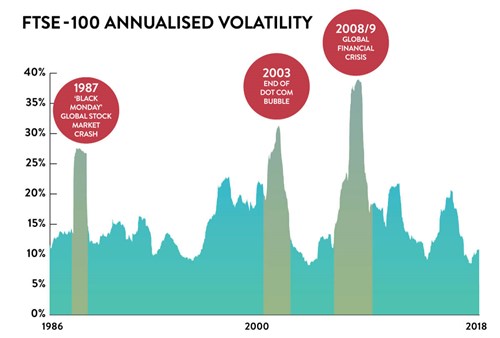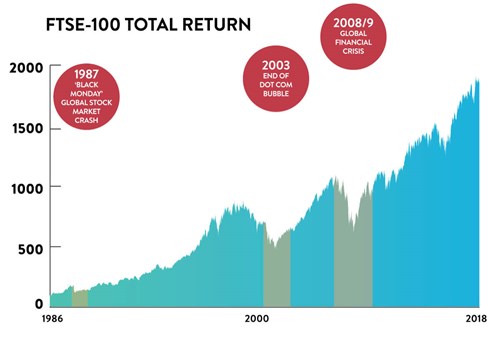Most people associate ‘market volatility’ with media images of stressed-looking stock brokers, jittery investors panic selling stocks, and endless infographics showing downward-pointing markets.
But to assume that volatility is always a bad thing for investors is to only tell half the story. Volatility can actually be as much about markets moving up as it is down, so it might not always be bad news for your investments.
What is market volatility?
Imagine driving on an undulating country road. You’ll be negotiating gentle ups and downs and changes of direction as you go, but progress is by and large, steady.
This is how, in an ideal world, stock markets would act – prices moving up and down steadily, with no big surprises.
But volatile markets are more like riding a roller coaster with unpredictable highs and lows. And the size and speed of these ups and downs is a measure of the level of volatility a market is experiencing.
What causes volatility in stock markets?
There’s not always an explanation for volatility. Sometimes it can come and go within days, or even hours. Other times, it can hang around for weeks or months.
In the graph below (which shows the historic annual volatility of the FTSE-100 from 1986 to 2018), you can see that the spikes in volatility have been due to particularly significant events or points of market stress. For anyone not in the know, the FTSE-100 is an index which lists 100 of the largest publicly traded companies based in the UK.
Over the 32 year period shown, volatility peaked during three of the most notable market events of the period: the ‘Black Monday’ global stock market crash in 1987, the end of the Dot Com Bubble in 2003, and the 2008-09 global financial crisis.


More recently, we have also seen volatility due to events such as the Covid-19 pandemic and the Russia-Ukraine conflict, as well as rising interest rates.
Volatility makes more of a marked appearance during market declines because, over this highlighted period, drops have tended to be much shorter than the rise in markets (except in Japan).
Consequently, periods of low volatility are often seen as a good sign for investors, since it has generally coincided with periods when equities have been pushing higher and producing returns for investors.
Too little volatility can also be a bad thing. Periods of persistent low volatility (during which markets might be consistently moving upwards) can be an indication of market complacency, which when valuations become stretched or political tensions bubble, spark fears of an impending market correction.
However, this can merely lead prices to fall back to more realistic and sustainable levels, as we saw in February 2018.
Why does uncertainty cause market volatility?
In a word, people. Investors are invariably human beings, or Blackbox algorithms programmed by humans. When motivated by the fear of losing our hard-earned money, we’re prone to acting emotionally, irrationally and illogically. And who can blame us?
Major political upheaval, financial scandals or even terrorist attacks can have us nervously hovering a finger over the ‘sell’ button. It’s this behaviour that often plays a significant role in driving volatility up. And as prices fall further, so more nervous investors hit the panic button, driving prices further into a downward spiral.
It’s the same human behaviour (known as behavioural bias) that causes stock market bubbles in the first place. The urge not to miss out on the ‘next big thing’ will often see investors buying an asset just because everyone else is, whether they understand the risk or not.
It’s this exact emotional purchasing that created the great Dutch Tulip Bubble of the 1630s and more recently, the rise and fall of Bitcoin.
Is high volatility always bad for investors?
High volatility is often considered to be a bad thing because people are understandably averse to losing money. The fear of losing money overwhelms their desire to potentially make higher gains by taking more risk, so they focus on trying to limit potential losses.
High volatility sounds like bad news for most investors since it typically means accepting higher risk and potentially higher losses, but it can also provide opportunities. After all, a risk isn’t always synonymous with loss. It can also mean potentially higher gains.
And remember, if volatility was always low, making a return would be far more difficult since prices would move more predictably. Volatility can present an opportunity to make gains, as long as you learn how to react to it.
How do I make volatility work for me?
The first thing to do is stay calm and keep your nerve. Markets are naturally volatile but if you hold onto your investments over the long-term and resist the urge to sell when markets are falling, you could ride out the volatility and hopefully benefit from higher market prices in the long run, giving you a return on your investment.
Market volatility is a key reason why many investors take a long-term approach, investing for a minimum of 5 years.
And it could be beneficial to make sure your portfolio is well diversified, too. Putting all of your money into one market or region will not give you the best protection against periods of high volatility, especially if it’s focussed in the same places as your portfolio.
In short, be disciplined and patient. To help you ride out periods of volatility. consider having a well-balanced portfolio of investments, be that a Wealthify Plan that we've created and are managing for you, or a portfolio you've built yourself, and look through short-term market ups and downs as simply bumps in the road.
This way, even if you’re riding a roller coaster it’ll feel like a relaxing drive in the country.
If you'd like to find out more, we've got similar blogs that can teach you about diversification as well as why you shouldn't put all your eggs (or money) into one basket.
Past performance is not an indicator of future results.
Please remember the value of your investments can go down as well as up, and you could get back less than invested.
Wealthify does not offer financial advice. Please seek financial advice if you're unsure about investing.



